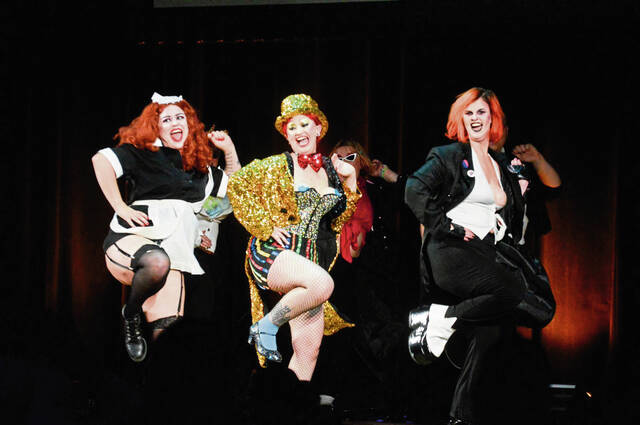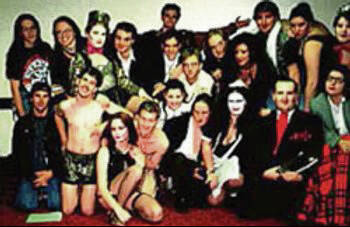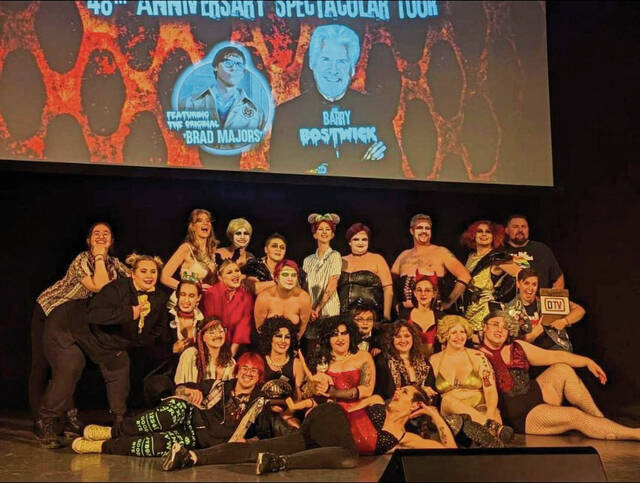50 years of 'The Rocky Horror Picture Show': looking back at the ultimate cult film
It’s been 50 years since the first American audiences saw a giant pair of crimson lips gracing their silver screens, singing an iconic opening song about “the late night double feature picture show.”
Since Sept. 26, 1975, fans around the world have embraced the quirky, raunchy and downright weird “Rocky Horror Picture Show,” and that appreciation has only grown since. The musical science fiction film was adapted from a 1973 musical theatre production, “The Rocky Horror Show,” which started out in London’s West End.
Fifty years later, “The Rocky Horror Picture Show” remains more than a cult classic — it’s a living tradition that thrives in theaters around the world, including in Pittsburgh, where fans have kept the experience alive through shadow casts, midnight screenings and a vibrant subculture of misfits and performers.
“Rocky Horror” was initially a box office flop, grossing just over $1 million in the United States and Canada upon initial release against a $1.5 million budget. But, thanks to continual showings — mostly midnight movie screenings — its total gross up to 2025 sits at about $160 million.
Cara Popovich, manager and events coordinator for Row House Cinema, defined “cult classic” as “a film that didn’t resonate with a wider audience at the box office and then had a resurgence through an underground crowd since its release.”
”The Rocky Horror Picture Show” is now the longest continually shown theatrical film in history.
The show and film’s creator, actor, comedian and musician Richard O’Brien looked back fondly at the film at its 50th anniversary.
“The thing is, I don’t mind. I got everything I ever wanted because of the show. I say ‘thank you’ every day for it,” he told Smithsonian magazine last month.
“The Rocky Horror Picture Show” follows straight-laced newly engaged couple Brad and Janet (played by Barry Bostwick and Susan Sarandon) as they get caught with a flat tire on a rainy night and venture to a strange castle in search of help. Instead, they meet Dr. Frank-N-Furter (Tim Curry), a gender-ambiguous scientist who’s created a buff Frankenstein monster named Rocky (Peter Hinwood) in his lab. It was inspired by the science fiction B-movies and British comedies of the early to mid-20th century.
For most fans, the plot is inconsequential; it’s all about the dynamic performance of Tim Curry, the campiness of the film and the rocking songs.
Its run as a cult film began at the Waverly Theater in New York City in 1976 when patrons began to yell jokes back at the screen, the seeds of a culture of callbacks that’s evolved over the decades. A lot of those callbacks aren’t fit to print, with explicit language and sexual innuendo tingeing most. Audience members often also have props that are used at certain points in the film; toast is thrown when Frank declares “a toast,” rice is thrown during a wedding and there’s a shower of playing cards when Curry sings “cards of sorrow, cards of pain” in the song “I’m Going Home.”
Local shadow cast origins
Many performances also include a “shadow cast” of actors who are dressed as the film’s characters and act out the film in real time in front of the screen. Pittsburgh was one of the first cities to begin the practice of “shadow casting” for “Rocky Horror.” The first cast here was directed by Adolph Huntermark, a member of the original New York cast who moved to Pittsburgh in the 1980s. According to the history of the Junior Chamber of Commerce Players, the lasting cast in the Pittsburgh area, “The cast had a reputation, like many at the time, as a tight-knit group of misfits who got together to do a show and party hard.”
Bill Hahner was involved in Pittsburgh shadow casts from about 1990 to 1995. He recalled the first time he ever saw “The Rocky Horror Picture Show” in the theater, several years before he started to participate.
“What was appealing way back then was that it was an underground thing,” he said. “It felt counterculture. It felt like going to a punk show.”
At the time, the movie was only available in theaters. “I remember getting a bootleg VHS tape, a really bad copy, at one point,” he said.
When Hahner first saw the film, the destination for “The Rocky Horror Picture Show” in Pittsburgh was the King’s Court Theater in Oakland, which closed in 1990. They started showing the film in 1978, and the earliest shadow casts began performing there in the 1980s.
In the early 1990s, “Rocky Horror” moved to the Hollywood Theater in Dormont, where it’s remained on and off ever since.
Ryan LaRocco played Dr. Frank-N-Furter, the iconic role played by Tim Curry in the film, from 1996 to 1999. But her “Rocky” history went back even further.
“I grew up not very far from the Hollywood Theater,” she said. “It always piqued my interest as a kid. … It was so close to my house that when I was about 13 or 14, I actually snuck over there.”
During her shadow cast tenure, LaRocco’s then-boyfriend-now-husband was also in the cast playing Rocky. She said many of the people she met through the movie’s subculture are still her good friends.
“It’s such an eclectic but tight-knit community,” she said. “There are people who go 50 times, you know? To this day, my friendships are primarily based on people I met through ‘Rocky Horror.’ … I think the majority of our wedding party were ‘Rocky Horror’ friends.”
It was at the Hollywood where Steven Chbosky, who penned the novel “The Perks of Being a Wallflower,” saw the film in the early 1990s and wrote the experience into the still-popular book. Scenes for the 2012 film adaptation were filmed at the Hollywood, and LaRocco was an extra.
“We were up on the balcony the night that they went. It was funny because we were screaming out our disgusting, horrible callbacks and Emma Watson is sitting a couple rows in front of us. It was pretty funny. Ezra Miller, he was laughing the whole time. But we were older, in our early 30s, when we did that,” LaRocco said.
After the theater’s closure, its purchase by Row House Cinema in 2023 and its subsequent renovation, showings have temporarily moved to Row House’s Lawrenceville location. The Junior Chamber of Commerce Players will return to the Hollywood this month ahead of the theater’s grand reopening on Nov. 6.
The JCCP has performed “Rocky Horror” at a number of venues over the years, including Bottlerocket Social Hall in Allentown, The Oaks in Oakmont and at Row House.
“We’ve been doing them twice a month for the last year at the Lawrenceville location,” said Popovich. “At the Hollywood, when it reopens, they will be more frequent.”
The Junior Chamber of Commerce Players will perform along with the film at Row House Hollywood at midnight Oct. 31 and Nov. 1.
Inclusive community
Last year, JCCP’s president Sam Bassett told TribLive that the community around the group is so strong that ex-cast members from as far back as the 1980s still attend showings. Though Hahner hasn’t been recently, he still remembers his heyday fondly.
Hahner started attending showings almost weekly after the film’s move to the Hollywood.
“That’s where you’d meet up with all your friends,” he said. “It was more of a social gathering.”
He joined the cast soon after — reticently — with a puppet of The Criminologist that he created in a class at the Art Institute of Pittsburgh. The puppet was so popular that he got a call from Rocky Horror Picture Show Fan Club president Sal Piro to participate in a national performance.
He recalled how the callbacks evolved over time. A lot of them were topical and wouldn’t resonate as well today.
In 1990, Tim Curry played the evil clown Pennywise in the TV miniseries based on Stephen King’s “It.” A scene in “Rocky Horror” shows Curry’s character floating in a pool. Hahner remembers “being one of the first to yell out, ‘Beep beep, Richie, we all float down here’ ” — a famous line from “It” spoken by Curry’s character. “I think people still use it. I don’t know if people get the context or not.
“Every generation puts their own stamp on it, and it becomes theirs,” he added.
Both Hahner and LaRocco remembered the DIY nature of assembling outlandish costumes from thrift store finds back in the 1990s, instead of ordering fully formed costumes from Amazon.
“Part of the fun was being on the hunt for things,” Hahner said.
So what’s made “Rocky Horror” last half a century, in Pittsburgh and all over the world?
“It gave people the opportunity to, it sounds corny, but, ‘don’t dream it, be it,’ ” LaRocco said, citing a refrain from one of the film’s songs. “Come dressed however you want and have a great time and be whoever you may be. They may think you’re weird at school, but everybody here thinks you’re pretty cool.”
The film’s culture is also a safe haven for many in the LGBTQIA+ community, especially younger people, to feel accepted. With themes of nonconformity around gender and sexuality, the film has allowed generations of people to embrace queer identities.
“ ‘Rocky Horror’ is so silly and it’s so over-the-top and it’s so campy that you can’t help but be swept up in it,” Popovich said. “Then, when you have these people acting it out in front of you, which is sort of exaggerating that camp and that ridiculousness, it makes it an immersive experience that people almost get addicted to. They feel like they’re really a part of something.”
“It might slow down a little bit, but it will always come back,” Hahner said. “They still sell out, those midnight showings … which is amazing.”
LaRocco hasn’t been to a showing in a long time but looks forward to going again.
“We have a 13-year-old son, and we plan to take him when (the Hollywood) reopens,” she said.
Alexis Papalia is a TribLive staff writer. She can be reached at apapalia@triblive.com.
Remove the ads from your TribLIVE reading experience but still support the journalists who create the content with TribLIVE Ad-Free.



